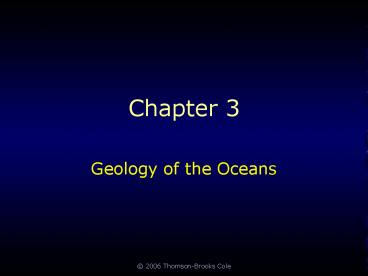Geology of the Oceans - PowerPoint PPT Presentation
1 / 50
Title:
Geology of the Oceans
Description:
The world ocean has four main basins: the Atlantic, Pacific, Indian, and Arctic. ... New seafloor is produced at ocean ridges and old ... Terrigenous sediments ... – PowerPoint PPT presentation
Number of Views:312
Avg rating:3.0/5.0
Title: Geology of the Oceans
1
Chapter 3
- Geology of the Oceans
2
Key Concepts
- The world ocean has four main basins the
Atlantic, Pacific, Indian, and Arctic. - Life first evolved in the ocean.
- The earths crust is composed of moving plates.
- New seafloor is produced at ocean ridges and old
seafloor is removed at ocean trenches.
3
Key Concepts
- The ocean floor has topographical features
similar to those found on continents. - The seafloor is composed of sediments derived
from living as well as nonliving sources. - Latitude and longitude determinations are
particularly necessary for precisely locating
positions in the open sea, where there are no
features at the surface.
4
World Ocean
- Primitive earth and formation of the ocean
- early earth thought to be composed of silicon
compounds, iron, magnesium oxide, and other
elements - gradually, the earth heated, causing melting and
separation of elements - water vapor locked within minerals released to
the surface, where it cooled, condensed, and
formed the ocean
5
World Ocean
- Ocean and the origin of life
- atmosphere formed by gases escaping from the
planet - no accumulation of oxygen until evolution of
photosynthesisfree oxygen forms oxides - Stanley Millers apparatus
6
(No Transcript)
7
(No Transcript)
8
World Ocean
- The ocean today
- 4 major ocean basins Pacific, Atlantic, Indian
and Arctic - seas and gulfs
9
(No Transcript)
10
(No Transcript)
11
Continental Drift
- Layers of the earth
- solid inner coreiron- and nickel-rich
- liquid outer core (same composition)
- mantlethickest layer with greatest mass, mainly
magnesium-iron silicates - crustthinnest and coolest, outermost
12
(No Transcript)
13
(No Transcript)
14
Continental Drift
- Moving continents
- Alfred Wegener
- Pangaea, Laurasia and Gondwanaland
15
(No Transcript)
16
Continental Drift
- Forces that drive continental movement
- magma convection currents
- midocean ridges form along cracks where magma
breaks through the crust - at subduction zones, old crust sinks into the
mantle where it is recycled - seafloor spreading causes continental drift
17
(No Transcript)
18
(No Transcript)
19
Continental Drift
- Evidence for continental drift
- fit of continental boundaries
- earthquakes
- seafloor temperatures highest near ridges
- age of crust, as determined by samples drilled
from the ocean bottom, increases with distance
from a ridge
20
(No Transcript)
21
(No Transcript)
22
(No Transcript)
23
Continental Drift
- Theory of plate tectonics
- lithosphere is viewed as a series of rigid plates
separated by earthquake belts - divergent plate boundariesmidocean ridges where
plates move apart - convergent plate boundariestrenches where plates
move toward each other - faultsregions where plates move past each other
(e.g. transform faults) - rift zoneswhere lithosphere splits
24
Continental Drift
- Rift communities
- depend on specialized environments found at
divergence zones of the ocean floor - first was discovered by Robert Ballard and J.F.
Grassle in 1977, in the Galápagos Rift - primary producers are chemosynthetic bacteria
25
Ocean Bottom
- Continental margins
- continental shelf, continental slope, and shelf
break - submarine canyons and turbidity currents
- continental rises
- shaping the continental shelves
- glaciers
- sediments
26
(No Transcript)
27
(No Transcript)
28
(No Transcript)
29
(No Transcript)
30
(No Transcript)
31
Ocean Bottom
- Ocean basin
- abyssal plains and hills
- seamounts
- ridges and rises
- trenches and island arcs
- Life on the ocean floor
- continental shelves are highly productive
- life on the abyssal plains is not abundant owing
to the absence of sunlight
32
(No Transcript)
33
(No Transcript)
34
(No Transcript)
35
Composition of the Seafloor
- Sedimentloose particles of inorganic and organic
material
36
Composition of the Seafloor
- Hydrogenous sediments
- formed from seawater through a variety of
chemical processes - e.g. carbonates, phosphorites
- Biogenous sediments
- formed from living organisms
- mostly particles of corals, mollusc shells,
shells of planktonic organisms
37
(No Transcript)
38
Composition of the Seafloor
- Terrigenous sediments
- produced from continental rocks by the actions of
wind, water, freezing, thawing - e.g. mud (clay silt)
- Cosmogenous sediments
- formed from iron-rich particles from outer space
which land in the ocean and sink to the bottom
39
(No Transcript)
40
Finding Your Way around the Sea
- Maps and charts
- Mercator projections
- bathymetric charts
- physiographic charts
41
(No Transcript)
42
(No Transcript)
43
(No Transcript)
44
Finding Your Way around the Sea
- Reference lines
- latitude
- longitude
- divisions of latitude and longitude
45
(No Transcript)
46
(No Transcript)
47
Finding Your Way around the Sea
- Navigating the ocean
- principles of navigation
- a sextant was used to determine latitude based on
the angle of the North Star with reference to the
horizon - longitude determined using chronometer
48
(No Transcript)
49
Finding Your Way around the Sea
- Navigating the ocean
- global positioning system (GPS)
- utilizes a system of satellites to determine
position - GPS measures the time needed to receive a signal
from 3 satellites, and calculates position
50
(No Transcript)































